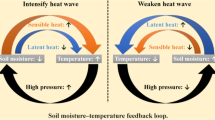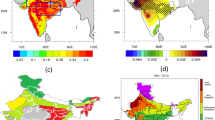Abstract
Surface heat and moisture fluxes are important to the evolution of a tropical storm after its landfall. Soil moisture is one of the essential components that influence surface heating and moisture fluxes. In this study, the impact of soil moisture on a pre-landfall numerical simulation of Tropical Storm Bill (2015), which had a much longer lifespan over land, is investigated by using the research version of the NCEP Hurricane Weather Research and Forecasting (HWRF) model. It is found that increased soil moisture with SLAB scheme before storm’s landfall tends to produce a weaker storm after landfall and has negative impacts on storm track simulation. Further diagnoses with different land surface schemes and sensitivity experiments indicate that the increase in soil moisture inside the storm corresponds to a strengthened vertical mixing within the storm boundary layer, which is conducive to the decay of storm and has negative impacts on storm evolution. In addition, surface diabatic heating effects over the storm environment are also found to be an important positive contribution to the storm evolution over land, but their impacts are not so substantial as boundary layer vertical mixing inside the storm. The overall results highlight the importance and uncertainty of soil moisture in numerical model simulations of landfalling hurricanes and their further evolution over land.
Similar content being viewed by others
References
Arndt, D. S., J. B. Basara, R. A. McPherson, et al., 2009: Observations of the overland reintensification of tropical storm Erin (2007). Bull. Amer. Meteor. Soc, 90, 1079–1093, doi: 10.1175/2009BAMS2644.1.
Beljaars, A. C. M., P. Viterbo, M. J. Miller, et al., 1996: The anomalous rainfall over the United States during July 1993: Sensitivity to land surface parameterization and soil moisture anomalies. Mon. Wea. Rev., 124, 362–383, doi: 101175/1520-0493(1996)124<0362:TAROTU>2.0.CO;2.
Betts, A. K., J. H. Ball, A. Beljaars, et al., 1996: The land surface-atmosphere interaction: A review based on observational and global modeling perspectives. J. Geophys. Res. Atmos., 101, 7209–7225, doi: 10.1029/95JD02135.
Bozeman, M. L., D. Niyogi, S. Gopalakrishnan, et al., 2012: An HWRF-based ensemble assessment of the land surface feedback on the post-landfall intensification of Tropical Storm Fay (2008). Nat. Hazards, 63, 1543–1571, doi: 10.1007/s110 69-011-9841-5.
Braun, S. A., and W. K. Tao, 2000: Sensitivity of high-resolution simulations of Hurricane Bob (1991) to planetary boundary layer parameterizations. Mon. Wea. Rev., 128, 3941–3961, doi: 10.1175/1520-0493(2000)129<3941:SOHRSO>2.0.CO;2.
Breuer, H., F. Ács, B. Laza, et al., 2012: Sensitivity of MM5-sim-ulated planetary boundary layer height to soil dataset: comparison of soil and atmospheric effects. Theor. Appl. Clima-tol, 109, 577–590, doi: 10.1007/s00704-012-0597-y.
Chen, F., and J. Dudhia, 2001: Coupling an advanced land surface-hydrology model with the Penn State-NCAR MM5 modeling system. Part I: Model description and implementation. Mon. Wea. Rev., 129, 569–585, doi: 10.1175/1520-0493 (2001)129<0569:CAALSH>2.0.CO;2.
Deardorff, J. W., 1978: Efficient prediction of ground surface temperature and moisture, with inclusion of a layer of vegetation. J. Geophys. Res. Oceans, 3, 1889–1903, doi: 10.1029/JC083iC04p01889.
Eltahir, E. A. B., 1998: A soil moisture-rainfall feedback mechanism: 1. Theory and observations. Water Resour. Res., 34 765-776, doi: 10.1029/97WR03499.
Emanuel, K., J. Callaghan, and P. Otto, 2008: A hypothesis for the redevelopment of warm-core cyclones over northern Australia. Mon. Wea. Rev., 136, 3863–3872, doi: 10.1175/2008 MWR2409.1.
Evans, C., R. S. Schumacher, and T. J. Jr. Galarneau, 2011: Sensitivity in the overland reintensification of Tropical Cyclone Erin (2007) to near-surface soil moisture characteristics. Mon. Wea. Rev., 139, 3848–3870, doi: 10.1175/2011MWR3593.1.
Ferrier, B. S., Y. Jin, Y. Lin, et al., 2002: Implementation of a new grid-scale cloud and precipitation scheme in the NCEP Eta model. 19th Conference on Weather Analysis and Forecasting/15th Conference on Numerical Weather Prediction. American Meteorological Society, San Antonio, TX.
Findell, K. L., and E. A. B. Eltahir, 2003: Atmospheric controls on soil moisture-boundary layer interactions. Part I: Framework development. J. Hydrometeorol., 4, 552–569, doi: 10.11 75/1525-7541(2003)004<0552:ACOSML>2.0.CO;2.
Gopalakrishnan, S. G., F. Jr. Marks, X. J. Zhang, et al., 2011: The experimental HWRF system: A study on the influence of horizontal resolution on the structure and intensity changes in tropical cyclones using an idealized framework. Mon. Wea. Rev., 139, 1762–1784, doi: 10.1175/2010MWR3535.1.
Gopalakrishnan, S. G., F. Jr. Marks, J. A. Zhang, et al, 2013: A study of the impacts of vertical diffusion on the structure and intensity of the tropical cyclones using the high-resolution HWRF system. J. Atmos. Sci., 70, 524–541, doi: 101175/JAS-D-11-0340.1.
Hart, R. E., and J. L. Evans, 2001: A climatology of the extratropical transition of Atlantic tropical cyclones. J. Climate, 14, 546–564, doi: 10.1175/1520-0442(2001)014<0546:ACOTET> 2.0.CO;2.
Horváth, Á., F. Ács, and H. Breuer, 2009: On the relationship between soil, vegetation and severe convective storms: Hungarian case studies. Atmos. Res., 93, 66–81, doi: 10.1016/j.at-mosres.2008.10.007.
Hou, D. C., M. Charles, Y. Luo, et al, 2014: Climatology-calibrated precipitation analysis at fine scales: Statistical adjustment of stage IV toward CPC gauge-based analysis. J. Hydro-meteorol., 15, 2542–2557, doi: 10.1175/JHM-D-11-0140.1.
Janjic, Z. I., R. Gall, and M. E. Pyle, 2010: Scientific documentation for the NMM solver. NCAR Tech. Note NCAR/TN-4771STR, NCAR, 53 pp, doi: 10.5065/D6MW2F3Z.
Jones, S. C., P. A. Harr, J. Abraham, et al., 2003: The extratropical transition of tropical cyclones: Forecast challenges, current understanding, and future directions. Wea. Forecasting, 18, 1052–1092, doi: 1011751520-04342003)018<1052TETO TC>2.0.CO;2.
Kishtawal, C. M., D. Niyogi, A. Kumar, et al, 2012: Sensitivity of inland decay of North Atlantic tropical cyclones to soil parameters. Nat. Hazards, 63, 1527–1542, doi: 10.1007/s11069-011-0015-2.
Koster, R. D., Z. C. Guo, R. Q. Yang, et al., 2009: On the nature of soil moisture in land surface models. J. Climate, 22 4322–4335, doi: 10.1175/2009JCLI2832.1.
Kurihara, Y., and R. E. Tuleya, 1974: Structure of a tropical cyclone developed in a three-dimensional numerical simulation model. J. Atmos. Sci, 31, 893–919, doi: 10.1175/1520-0469 (1974)031<0893:SOATCD>2.0.CO;2.
Lanicci, J. M., T. N. Carlson, and T. T. Warner, 1987: Sensitivity of the Great Plains severe-storm environment to soil-moisture distribution. Mon. Wea. Rev., 115, 2660–2673, doi: 10.1175/1520-0493(1987)115<2660:SOTGPS>2.0.CO;2.
Lin, L-F., and Z. Pu, 2018: Characteristics of Background Error Covariance of Soil Moisture and Atmospheric States in Strongly Coupled Land-Atmosphere Data Assimilation. J Appl. Meteorol. Climatol, 57, 2507–2529.
Pan, H.-L., and J.-S. Wu, 1995: Implementing a mass flux convection parameterization package for the NMC medium-range forecast model. NMC Office Note 409. U.S. National Center for Environmental Prediction, Washington, DC, 40 pp.
Pu, Z., H. Zhang, and J. A. Anderson, 2013: Ensemble Kalman filter assimilation of near-surface observations over complex terrain: Comparison with 3DVAR for short-range forecasts. Tellus A, 65, 19620.
Pu, Z., S. X. Zhang, M. J. Tong, et al., 2016: Influence of the self-consistent regional ensemble background error covariance on hurricane inner-core data assimilation with the GSI-based hybrid system for HWRF. J. Atmos. Sci., 73, 4911–4925, doi: 10.1175/JAS-D-16-0017.1.
Rossow, W. B., Y. C. Zhang, and G. Tselioudis, 2016: Atmospheric diabatic heating in different weather states and the general circulation. J. Climate, 29, 1059–1065, doi: 10.1175/JCLI-D-15-0760.1.
Schwarzkopf, M. D., and S. Fels, 1991: The simplified exchange method revisited: An accurate, rapid method for computation of infrared cooling rates and fluxes. J. Geophys. Res. Atmos., 96, 9075–9096, doi: 10.1029/89JD01598.
Shen, R. J., E. R. Reiter, and J. F. Bresch, 1986: Some aspects of the effects of sensible heating on the development of summer weather systems over the Tibetan Plateau. J. Atmos. Sci, 43, 2241–2260, doi: 0.1175/1520-0469(1986)043<2241:SAO TEO>2.0.CO;2.
Sirutis, J. J., and K. Miyakoda, 1990: Subgrid scale physics in 1-month forecasts. Part I: Experiment with four parameterization packages. Mon. Wea. Rev., 118, 1043–1064, doi: 10.11 75/1520-0493(1990)118<1043:SSPIMF>2.0.CO;2.
Smith, R. K., 2003: A simple model of the hurricane boundary layer. Quart. J. Roy. Meteor. Soc, 129, 1007–1027, doi: 10.1256/qj.01.197.
Tallapragada, V., L. Bernardet, M. K. Biswas, et al., 2014: Hurricane Weather Research and Forecasting (HWRF) Model: 2014 Scientific Documentation. NCAR HWRF Development Testbed Center Tech. Rep., 99 pp.
Troen, I. B., and L. Mahrt, 1986: A simple model of the atmospheric boundary layer; sensitivity to surface evaporation. Bound-Layer Meteor, 37, 129–148, doi: 10.1007/BF00122 760.
Tuleya, R. E., 1994: Tropical storm development and decay: Sensitivity to surface boundary conditions. Mon. Wea. Rev., 122, 291–304, doi: 0.1175152004931994)122<029:TSDAD S>2.0.CO;2.
Wu, C.-C., and Y. Kurihara, 1996: A numerical study of the feedback mechanisms of hurricane-environment interaction on hurricane movement from the potential vorticity perspective. J. Atmos. Sci., 53, 2264–2282, doi: 10.1175/1520-0469(1996) 053<2264:ANSOTF>2.0.CO;2.
Zhang, F. M., and Z. X. Pu, 2017: Effects of vertical eddy diffus-ivity parameterization on the evolution of landfalling hurricanes. J. Atmos. Sci., 74, 1879–1905, doi: 10.1175/JAS-D-16-0214.1.
Zhang, F. M., Z. X. Pu, and C. H. Wang, 2017: Effects of boundary layer vertical mixing on the evolution of hurricanes over land. Mon. Wea. Rev., 145, 2343–2361, doi: 10.1175/MWR-D-16-0421.1.
Zhang, J. A., D. S. Nolan, R. F. Rogers, et al., 2015: Evaluating the impact of improvements in the boundary layer parameterization on hurricane intensity and structure forecasts in HWRF. Mon. Wea. Rev., 143, 3136–3155, doi: 10.1175/MWR-D-14-00339.1.
Zheng, X. Y., and E. A. B. Eltahir, 1998: A soil moisture-rainfall feedback mechanism: 2. Numerical experiments. Water Resour. Res., 34, 777–785, doi: 10.1029/97WR03497.
Acknowledgments
This study is initially conducted when the first author (FZ) visited the University of Utah. The research was supported by National Science Foundation Award #AGS-1243027 (ZP and FZ). High-performance computing support from Yellowstone (ark:/85065/d7wd3xhc), provided by NCAR’s Computational and Information Systems Laboratory (CISL) and the Center for High-Performance Computing (CHPC) at the University of Utah, is greatly appreciated. Authors also thank the Development Testbed Center (DTC) at the National Center for Atmospheric Research (NCAR) for their efforts to make the community research version of the HWRF model available on a public website. The first and third authors (FZ and CW) were also supported by the National Natural Science Foundation of China (41805032), and the Fundamental Research Funds of the Central Universities (lzujbky-2017-71).
Two anonymous reviewers are appreciated for their constructive comments that are very helpful for improving the manuscript.
Author information
Authors and Affiliations
Corresponding author
Additional information
Supported by the US National Science Foundation (AGS-1243027), National Natural Science Foundation of China (41805032), and Fundamental Research Funds of the Central Universities (lzujbky-2017-71).
Rights and permissions
About this article
Cite this article
Zhang, F., Pu, Z. & Wang, C. Impacts of Soil Moisture on the Numerical Simulation of a Post-Landfall Storm. J Meteorol Res 33, 206–218 (2019). https://doi.org/10.1007/s13351-019-8002-8
Received:
Accepted:
Published:
Issue Date:
DOI: https://doi.org/10.1007/s13351-019-8002-8




